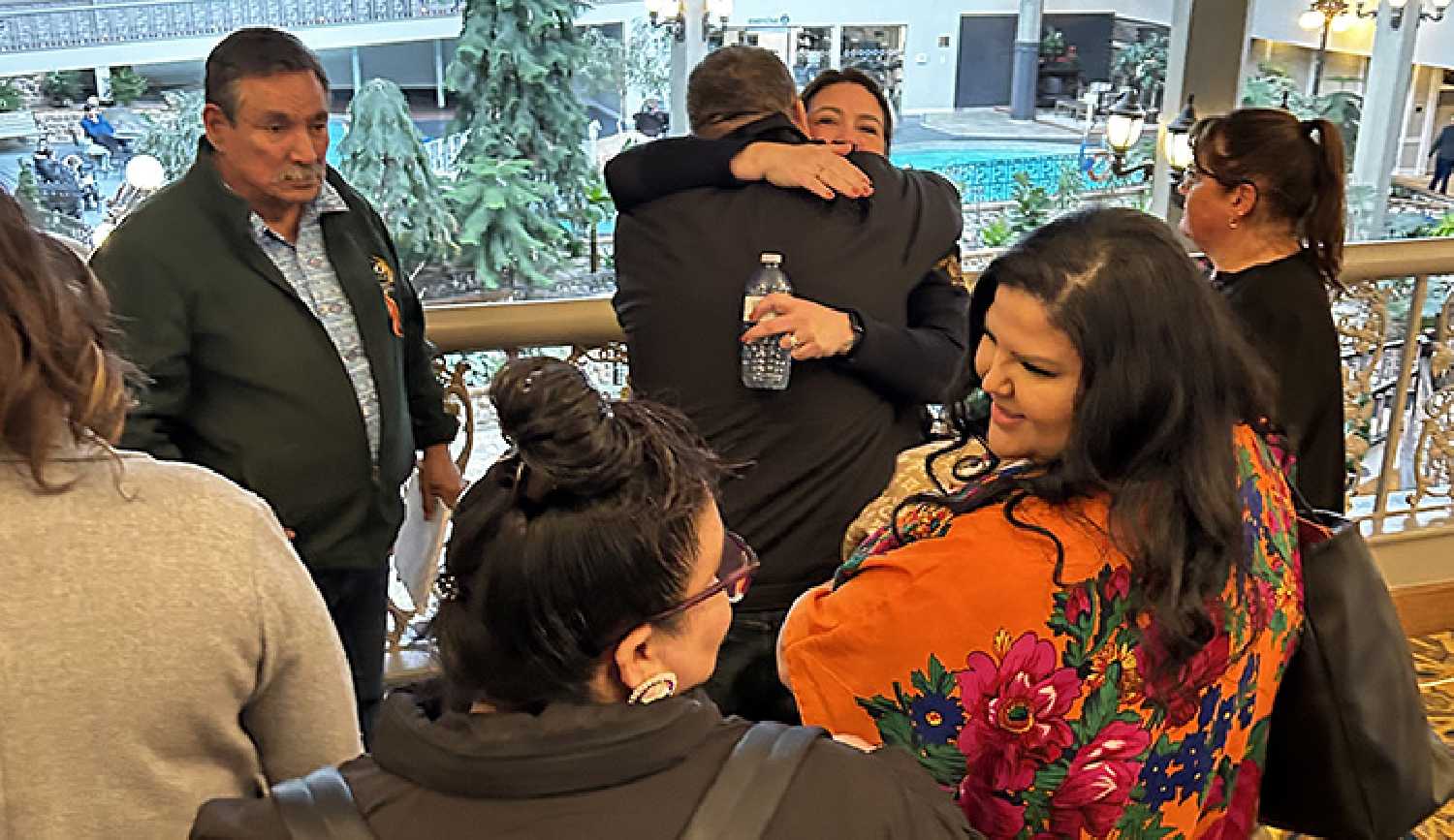Coroner’s inquest into death of Myles Sanderson held in Saskatoon
Drugs and heart condition cause of killer’s death
March 5, 2024, 1:05 pm
Ryan Kiedrowski, Local Journalism Initiative Reporter


A high-speed chase, risky vehicular takedown and fatal drug overdose. These aspects received hyper-focus during a four-day coroner’s inquest in Saskatoon last week. The goal of the inquest was to discover facts about the final hours of Myles Sanderson—the man solely responsible for the Sept. 4, 2022 mass killing on the James Smith Cree Nation and nearby Village of Weldon. Sanderson fatally stabbed 11 people during his rampage and was responsible for 17 attempted murders during that weekend.
The inquest, presided by coroner Robert Kennedy, ran from Feb. 26 to 29, hearing from medical experts, responding police officers, and emergency responders that were in contact with Sanderson when he died in custody on Sept. 7.
High-risk takedown
During the early afternoon of Sept. 7, 2022, a ‘be on the look out’ or BOLO alert was issued to RCMP detachments throughout the region Sanderson was believed to be in. Police learned of a home invasion near Wakaw just after 2 pm when Sanderson stole a white 2008 Chevrolet Avalanche and subsequent reports emerged of him at the One Arrow First Nation with an emergency alert hitting cell phones across Saskatchewan at 2:49 pm.
Cst. Brianne Hathaway, an RCMP member who was part of the Warrant Enforcement and Suppression Team (WEST), responded as a plainclothes officer in an unmarked vehicle that day.
“I knew that One Arrow First Nation was very close by where I was off of Highway 312, so I decided to pull over,” she told the jury. “Just after the bridge, I pulled over just to get my bearings and where it was in association to where One Arrow First Nation was.”
Cst. Hathaway would encounter the suspect vehicle very soon.
“Within probably a minute of me being on my phone and my map, I looked up and I saw a white Chev truck,” she said. “As it passed me, I took a look and I noticed that it was a white Chevrolet Avalanche. So at that time I put my phone down, did a U-turn on the highway and started to get in position to try and get in behind that white Avalanche to confirm the license.
“I noticed a police vehicle coming eastbound on Highway 312 and at that time I heard on the radio from that police vehicle that they had spotted the white Avalanche and there was a grey Jeep Cherokee following quickly behind it,” continued Hathaway. “At that time, I knew that was myself so I got on to the radio and said, ‘that’s me, that’s Cst. Hathaway with WEST and that I’m currently behind what I believe to be the suspect vehicle’.”
Cst. Bill Rowley was working at the Rosthern Detachment on that fateful day when he heard the same BOLO call come over dispatch.
“It was a very dramatic unfolding situation. It was obviously very dangerous,” Cst. Rowley recalled. “Some extremely high speeds, up to one point 167 km an hour.”
Coroner’s counsel Timothy Hawryluk asked Cst. Rowley if he’d ever experienced anything like this in his 23-year career with the RCMP.
“I have been in multiple pursuits before but nothing of this magnitude,” he replied. “It was very alarming and very concerning, I honestly thought that there was going to be collisions at that point.”
Sanderson sped west along Highway 312 with police trailing behind. He then turned in to the Gas Plus at the intersection of Highway 312 and Highway 11 at Rosthern, leading RCMP around the establishment, then onto the northbound lane of Highway 11 heading the wrong way.
As the jury learned, there were points during the high-speed chased where Sanderson appeared to be aiming at oncoming vehicles while driving the wrong way down Highway 11.
“I do recall certain instances where there were some very, very close calls to the point where I thought there was going to be a head-on collision,” said Cst. Rowley. “There were several vehicles that ended up having to take a ditch doing evasive action to avoid a head on collision.”
Meanwhile, Cst. Sean Nave set up a spike belt along the highway, preparing for Sanderson’s arrival.
“I definitely felt fear for my life,” he testified, adding that he was planning what his escape route might be should the truck come for him. “Very vulnerable is an understatement. I truly did feel I was in a very vulnerable position to be hit.”
At the lead of a four-vehicle diamond formation of RCMP members behind Sanderson was Cst. Heidi Marshall. Her actions were pivotal in stopping Sanderson, performing a precision immobilization technique (referred to as a PIT maneuver) while reaching speeds of 139 km/hr.
“Once close enough, the Explorer (Cst. Marshall’s vehicle) made contact,” explained Detective Sergeant Kenneth Kane of the Saskatoon Police Service. “It is important to note that the contact was not sudden nor hard, the impact was light, which then transitioned into the push. The pushing action by the Explorer caused the truck to rotate clockwise around the front of the Explorer. This allowed the RCMP officer to escape the maneuver and decelerate at a safe rate as the Avalanche continued on the highway while rotating.”
The Avalanche then came to rest in the ditch, miraculously avoiding a rollover. Minimal damage was noted on both vehicles involved, with the truck Sanderson drove noting a broken taillight, some rubber transfer from the police efforts and a bent exhaust pipe from going into the ditch. The RCMP vehicle noted a crumpled front bumper, lighting assembly damage and cracks to a corner panel.
“The damage here seems to be extraordinarily limited,” Kane noted, noting of the police vehicle “I would refer to it as cosmetic damage, really.”
Hawryluk asked Kane about his personal experience in training for such driving situations. Kane had in fact been trained in performing a pit maneuver, but added they are used at low speeds. He noted anything over 80 km per hour would be considered dangerous, that Cst. Marshall’s actions were “last resort” when no other option was present.
“At that point, the outcome is not reliable, meaning it is unknown,” remarked Kane. “So to say that she perfectly executed this is not an overstatement, it’s exactly what happened. The fact that she did it at this speed with that ability is frankly quite unbelievable and so it definitely is the best outcome.”
While an operational success, Cst. Marshall noted having her children on her mind as the pursuit first engaged the wrong way down Highway 11.
“While I was on the road, I was thinking, ‘this could be it’,” she recalled. “The one thing in my life that I always wanted was to be a mom. I did not want to leave my family without a mom.”
Immediately after the vehicle was disabled, police descended upon the driver’s side of the truck—complete with two RCMP vehicles providing rolling cover.
In response to Cst. Marshall’s emotional testimony, members of JSCN reciprocated compassion. Eddie Head, representing the family of Beverly Burns, had standing at the inquest. When asked if he had any questions for Cst. Marshall, he spoke of how JSCN members are also going through their own emotional process.
“We support you for what you’re doing, keep up the good work,” Head told Cst. Marshall, extending an invitation to JSCN in the spirit of healing. “You’re not alone, come and talk to us.”
Several members of JSCN were seen embracing Cst. Marshall after the second day of the inquest.
Arrest and medical distress
After the successful PIT maneuver, RCMP were able to safely surround the Avalanche and prepare to interact with the driver.
Cst. Rowley along with Cst. Travis Adema were the officers who removed Sanderson from the truck, arresting him facedown before holding him to an RCMP vehicle in order to frisk the man.
“I had a lot of safety concerns for myself, my co-workers, the public and for Myles himself,” said Cst. Adema. “I truly felt that apprehending him as quickly as possible, as safely as possible, was the only way to make this come to a conclusion.”
Cst. Rowley had opened the driver’s side door and recounted his thoughts in those frantic moments.
“I was under the expectation that he was coming out to finish some unfinished business,” he said. “I didn’t think it was going to go down the way it did. I expected him to come out with either a knife or a firearm, and I thought it was going to turn into a shootout.”
After managing to handcuff Sanderson, Cst. Rowley described the man’s demeanour as officers searched him.
“His attitude was very smug, cocky and arrogant,” Cst. Rowley explained. “He was laughing, directing comments to us that we should have shot him, asking how many bodies he got and was just very arrogant for somebody that had done something like that. It seemed like it was just a continuation of what happened probably from day one.”
Cst. Rowley recalls Sanderson acting “totally normal” as police searched him, seemingly not under the influence of drugs or alcohol. Cst. Rowley was holding Sanderson up, walking him to the police vehicle when that demeanour quickly changed.
“As I was about to put him inside, his body felt like it actually stopped,” Cst. Rowley remembered, adding that from past experience with people not wanting to enter an RCMP vehicle, he assumed Sanderson was balking as well.
“Seconds later, his body became heavier, he kind of fell into my body, so I was supporting his body weight,” he said.
Within a couple minutes, Sanderson went from alert and communicative with RCMP to convulsing in grand mal seizures on the ground. Via video and audio from an RCMP Watchguard system, officers called for medical help, asking Sanderson if he took anything. The barely audible response of “meth” could be heard, perhaps the man’s final spoken word.
When paramedics arrived, Cst. Adema noticed a plastic bag in Sanderson’s hand.
“When I looked at it further, I was able to see a clear plastic corner bag,” he said. “There was a white powder in there that I had seen and a green piece of paper. In my policing experiences, I know that if that was an illicit substance or a drug, it’s not uncommon for people that use these substances to roll up something like a piece of paper to nasally ingest whatever substance that is, so effectively like ingesting it through a straw.”
Cst. Adema then passed the bag—which the later investigation confirmed to be a bag of cocaine with a rolled up $20 bill inside—to Cst. Marshall in order to secure the evidence. The jury heard that Naloxone was administered to Sanderson twice.
Through testimony, the inquest learned Sanderson died from acute cocaine overdose with 6.5 mg per litre of the substance in his blood combined with previously noted atherosclerosis.
According to Nick Machan, Operations Superintendent with Ottawa Paramedics, previous knowledge of cocaine intoxication would not have changed their mode of treatment at all. He was part of the team that arrived moments after Sanderson began to experience seizures at the site of his arrest until an ambulance arrived.
Machan and Cst. Nave would go on to be part of the crew in that ambulance taking Sanderson to Royal University Hospital in Saskatoon, where Sanderson was declared deceased.
Experts point to overdose
According to Saskatchewan’s Chief Forensic Pathologist, Sanderson died from a high level of cocaine in his system; a possible trigger to underlying atherosclerosis, a narrowing of a heart artery. That’s what Dr. Shaun Ladham noted in his testimony.
No blunt-force trauma or signs of asphyxiation were noted from the autopsy report, nor were there signs of fractures or external injuries.
Dr. Ladham also confirmed the Naloxone would have made no difference to Sanderson, explaining that it acts against opioid receptors (morphine or fentanyl, for example).
“It wouldn’t have changed what happened in this case,” he said.
Forensic toxicologist Dr. Jennifer Billinsky agreed with Dr. Ladham’s findings, calling the level of cocaine in Sanderson’s system the highest peak she’s viewed.
“That’s a very, very high reading,” Dr. Billinsky said in her testimony. “It’s one of the highest cocaine levels I’ve ever seen in my career at the Roy Romanow lab.”
She added that the cocaine was very strong, finding it 90 per cent pure. Based on toxicology reports, the amount of cocaine in Sanderson’s system was 10 times the lethal amount.
“We didn’t have any specific details as to the extent of the potential trauma, just the events leading up to his cardiac arrest,” Dr. Willian Papenfus, who was in the RUH emergency room on Sept. 7, 2022, told the jury. “As soon as he arrived, we started to assume care.”
When Sanderson came into the ER, staff had no confirmation of his exact state.
“We’d heard that there was suspicion that he might have ingested a white powder, but they didn’t document the details,” Dr. Papenfus said. “But there was just this thought that he might have ingested the powder, and then fairly rapidly deteriorated from what sounded like an excited state to essentially having a cardiac arrest.”
The final witness providing testimony at the inquest was Dr. Matt Logan, a criminal investigative psychologist working with the RCMP. He co-authored a post mortem behavioural analysis report on Sanderson, and has a background as an FBI-trained hostage negotiator.
At the beginning of the report, Dr. Logan outlined Sanderson’s early life experience.
“Growing up, he had a very difficult childhood. It was rife with abuse and instability,” Dr. Logan said. “He basically went from one home to another, from his mother’s home to his father’s home to his grandparents’. And so here were a lot of things happening in his childhood that I would refer to as adverse childhood experiences.”
The report also referenced sporadic employment and Sanderson’s formal education reaching a portion of Grade 10.
“As a student, he was suspended and expelled a number of times and a lot of truancy present where he just did not appear to come to school on many days,” Dr. Logan stated.
Substance abuse was a part of Sanderson’s life from age 13, including methamphetamine, cocaine, marijuana and alcohol.
“Probably the drug of choice in the last number of years, from everything I could ascertain, was cocaine, and he used it considerably,” Dr. Logan remarked.
He also referenced a Psychopathy Checklist that saw Sanderson score in the 90-94th percentile. Dr. Logan went on to describe him as fitting the definition of a mission-oriented offender, noting in part “they do not appear frenzied or manic, but rather hypo emotional, in spite of the extreme carnage that are creating.
“We believe that he selected the victims in a way that was not typical, and we typically see somebody that has absolutely in the mind of a killer being wronged by that person,” Dr. Logan said. “In this case, we saw some victims that were selected for that reason, but many were selected because what the killer felt was an association with the Terror Squad.”
Previous to the police chase on Highway 11, Sanderson had lingered at a rural residence near Wakaw, where he eventually stole the truck at the centre of the RCMP pursuit.
“We are of the opinion that the Mr. Sanderson spent quite a bit of time on her property,” Dr. Logan explained. “He was also finding food in the garage and the fridge and the freezer. When he finally decided to make contact with the victim, she was terrified.”
Dr. Logan believes the end target of Sanderson’s ‘mission’ was his common-law partner, Vanessa Burns, who lived in Saskatoon at the time.
As for the cause of death, Dr. Logan pointed to accidental overdose.
“It’s obvious he caused his own death, but the question is, did he intend the actions to cause his death? And so in our belief, he was not taking the cocaine in order to die, but he didn’t care whether he died or not,” he said.
Community continues to heal
Throughout the inquest, video of the high speed chase, vehicular takedown and initial medical care of Sanderson was played. While difficult to observe, Chelsea Stonestand (who represented the family of Bonnie and Gregory Burns at the Melfort inquest) noted it was an important part of the healing process.
“I think seeing those videos and seeing the dynamics play out, I think that has definitely helped a lot of members healing,” she said.
Kim Beaudin, National Vice-Chief with the Congress of Aboriginal Peoples, attended both the inquest in Saskatoon and the previous coroner’s inquest held in Melfort weeks prior that focussed on the 11 deaths at the hands of Sanderson. One thing that impressed Beaudin was the view of police in general.
“It gave a really excellent overview in terms of how the police work,” he said of the Saskatoon inquest. “They also humanized the officers as well. A lot of times, we think that the officers are cold, stoic and not in touch with really a whole lot of things. They’re dealing with so much stuff all the time.”
Discovering the facts of how Sanderson died was also important in the face of alternative statements.
“There’s conspiracy theories out there that the RCMP took him out,” said Beaudin. “Well, that clearly wasn’t the case.”
He went on to explain how the Sept. 4 mass stabbings had wide-reaching impacts across the country.
“What happened here impacted all Indigenous people. We all felt it. We feel that—whether you’re on or off reserve,” he said. “You’re dealing with homelessness, you’re dealing with issues around mental health and drug addictions and gangs and all this stuff. It’s having a huge impact on communities and I think it’s going to get worse before it gets better.”
One of the 29 recommendations from the Melfort inquest especially struck a chord with Beaudin.
“The creation of a police service within reserves I think is paramount now, and it needs to happen,” he said.
CAP is advocating for changes to the justice system, noting in a media release issued on the same day of the inquest’s findings that “the incidents demonstrate an ongoing failure to implement the recommendations of past reports.”
“What this inquest highlighted are the consequences of misallocation of resources everywhere in Canada’s colonial justice system,” Beaudin said in the release, “There is never a shortage of correctional staff for prisons and jails, but always a shortage of caseworkers, community services and Elders to support healing for individuals and communities.”
Jury findings and recommendations
After six hours of deliberations, the six-person jury returned with their findings and recommendations, having processed four long days of information. They found Sanderson died at 4:39 p.m. on Sept. 7, 2022 at the RUH. Cause of death was found to be acute cocaine toxicity and the manner of death was deemed accidental.
The jury also made four recommendations, firstly to the SPS that they consider establishing a dedicated team tasked with arresting individuals subject to outstanding warrants.
The remaining three recommendations were for the RCMP to consider implementing mandatory enhanced driver training that includes the PIT maneuver; consider a review and policy of criteria in a high-speed pursuit in the interest of the safety of all involved; and to consider implementing additional training in the form of enhanced extraction techniques for the purposes of arrest takedowns.



































